
Finding Success in Africa–“Life-saving Paint”from Kansai Paint
アフリカで開花、関西ペイントの「命を救う塗料」
Extracted from Nikkei Business Online
Published on October 19, 2016
Author: Satoshi Ebitani
*In case of doubt or discrepancy in the two versions, the Japanese version of the article shall prevail.
出遅れた世界市場攻略の秘策
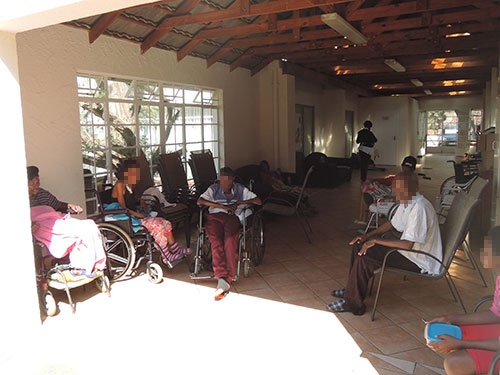
南アフリカ共和国のヨハネスブルク東部にある終末医療施設、セントフランシス・ケアセンター。
入院する患者に今、小さな奇跡が起きている。
南アフリカ共和国の最大の都市、ヨハネスブルクから東にクルマで約30分。大通りを1本折れると、それまでの喧騒から切り離された閑静な住宅街に入る。その一角にある古い教会の敷地内に、目的の施設はあった。
「セントフランシス・ケアセンター」。末期がんやエイズウイルス(HIV)感染者など、余命の限られた患者を対象に、終末医療を施すホスピスである。身寄りのない幼児30人を含む約60人の患者が生活している。その少なくない数の患者が、ここで最期を迎えるという。
そんな施設で今、ある小さな “奇跡”が起きている。
今年2月にホスピスに入院した女性、ミシェル・ハメレさん(仮名、18歳)。当時既にHIVに感染、発症こそしてはいないものの、免疫力は低下の一途をたどっていた。入院時の体重は31kg、身長は約130cm。年齢の割に明らかに身長が小さく、咳も止まらなかった。
通常の患者なら、そのまま衰弱し、やがて病気を発症して亡くなっていく。ところが、ハメレさんのケースはこれに当てはまらなかった。ホスピスでの 生活が始まると、彼女の体調は劇的に変わったのだ。「日を追うごとに、健康状態が回復、顔色もよくなり、食欲も出るようになった」と、ホスピスの看護責任 者であるウィニー・ドゥラミニ氏は驚く。入院から8カ月後には体重が52kgにまで増加。止まらなかった咳もほとんど出なくなった。
回復の理由は、一義的には看護師が施した的確な治療の効果だが、当の看護士は「治療以外にも理由がある」(ドゥラミニ氏)と言う。そして、棟内の壁を指差した。
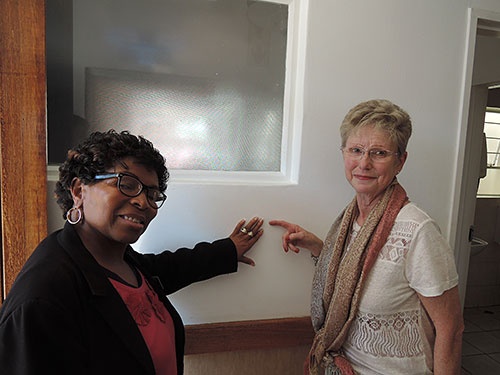
ホスピス内にはウイルスを不活性化する特殊な塗料が塗られている。
ホスピスの代表を務めるシンシア・ディックス氏(右)と看護責任者のウィニー・ドゥラミニ氏(左)
実は、院内には特殊な塗料が塗られている。「塗料を塗って以降、多くの患者の体調が改善している」。ホスピスの代表を務めるシンシア・ディックス氏は言う。
特殊塗料には、日本のしっくいに使われる消石灰成分が含まれている。塗ると、表面に無数の微細な孔ができる。そこにウイルスが吸着すると、細孔内部の高アルカリ状態が、ウイルスを不活性化させる。細菌、臭いの成分やカビなども同様の仕組みで細孔に閉じ込め、最後は殺してしまう。つまり、特殊塗料を塗った部屋は、通常よりもバクテリアやウイルスを劇的に少なくできる。
免疫力が低下したエイズ患者は、通常なら害のない種類のウイルスやカビであっても、病気を発症する可能性がある。彼らにとって、無菌に近い環境は、それだけで延命効果につながる。
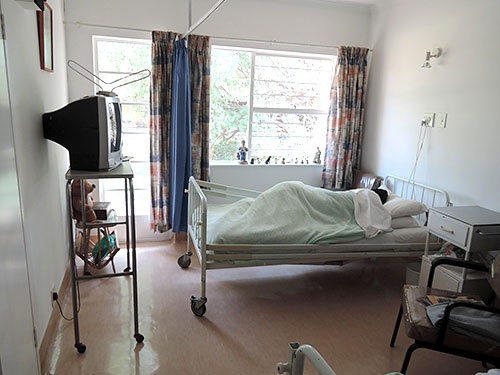
HIV感染者の生活を劇的に改善し、失われていたかも知れない命を救った特殊塗料。実は開発したのは、塗料大手の関西ペイントだ。日本では、「アレスシックイ」という名称で2008年に発売している。自然素材として古くから用いられてきたしっくいの機能を組み込み、住宅やオフィス向けの高付加価値塗料を展開している。一度塗ると、効果は7~8年ほど持続する。高級ホテルや高級列車の車内などにも使われている。
関西ペイントは当初、消臭やカビ防止効果をしっくい塗料の訴求点としてきたが、その後の研究によって塗料がそれ以上の効能を持つことを発見した。科学的に検証するため、2015年に長崎大学熱帯医学研究所と提携し、ウイルスやバクテリアへの効果について実験を重ねた。
結論は関西ペイントの予想を超えるものだった。HIVのほか、エボラウイルス、鳥インフルエンザウイルスなどにも効果があることが分かったのだ。成果は昨年11月、日本ウイルス学会学術集会でも展示している。
長崎大学との検証結果を受けて、関西ペイントはしっくい塗料の新たな販路開拓の検討を進めている。それが、アフリカを代表とする新興国への展開 だ。「社会問題となっているHIVやエボラウイルスなどの感染症に対して、塗料を使った予防策を政府関係者などに提案している」と関西ペイントの赤木雄執 行役員は言う。
この計画を大きく後押ししたのが、冒頭のホスピスでの成果だった。
南アフリカ日本大使館からの依頼
「しっくい塗料をホスピスに塗っていただけませんか」
2015年、関西ペイントに依頼が舞い込んだ。依頼主は、南アフリカの日本大使館だった。それ以前、関西ペイントの赤木氏は同大使館の廣木重之大 使にしっくい塗料の説明をしたことがあった。「塗料の効能について、大変興味を示されていた」と赤木氏は振り返る。その後、南アフリカ大使館は古くから関 係があったセントフランシス・ケアセンターの改修を、ODA(政府開発援助)を通じて支援することになった。ここで、しっくい塗料を塗るというアイデアが 生まれた。
関西ペイントにとっては、実際の効果を調べるには願ってもない機会だ。申し出にすぐに応じ、実際に塗る際には関西ペイントの社員もホスピスに駆け付けた。
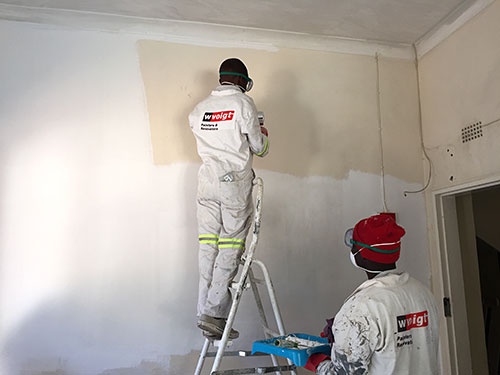
ホスピス内にしっくい塗料を塗っている様子
記者も実際にホスピスを訪れ、院内を歩いた。湿気を吸収しているからだろうか、塗料を塗った部屋は一様に涼しい。特有の陰鬱した雰囲気はあまりなく、むしろ清潔で明るい印象を持った。日差しを浴び、笑みを浮かべながら佇む患者の姿が印象的だった。
世話役の看護士も、塗料の効果を実感する声を多く聞いた。彼女たちは「患者の体調は目に見えて改善している」と口を揃える。院内の雰囲気も随分と明るくなったと言う。
もともと関西ペイントは、自動車向け塗料ビジネスに強く、消費者向けの建築用塗料での存在は小さかった。海外市場拡大を目指し、同社はアフリカを始め世界各国で建築向け塗料ビジネスを強化している。その意味で、しっくい塗料は海外展開の強力な武器となる可能性を秘めている。
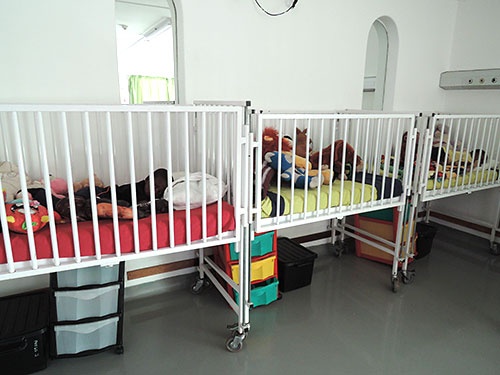
しっくい塗料は子供病棟にも塗られた
もちろん、課題もある。一つは、しっくい塗料の効能を、より精緻に検証していく必要がある点だ。看護師の証言は確かに有益だが、現状は主観の域を出ない。科学的根拠が検証されたわけではないため、今後、大学などと共同で効果を検証していく必要がある。
さらに大きなハードルは、アフリカで商品を販売して採算があうかという点だ。特殊塗料を現地で調達するための調達網、生産方法の移転に加え、現地 で広げるためのマーケティング費用などを考えると、コストはそれなりにかかる。一方で、アフリカの平均所得は先進国のそれに比べまだまだ低く、採算を合わせるには相当の工夫が要る。
関西ペイントは、もう1つの特殊塗料である「蚊を寄せ付けない塗料」の展開でNGO(非政府組織)と連携しているが、しっくい塗料でも同様の方法を検討している。これら以外にも、認証機関からのお墨付きをもらうなど、踏むべき手続きは無数にある。
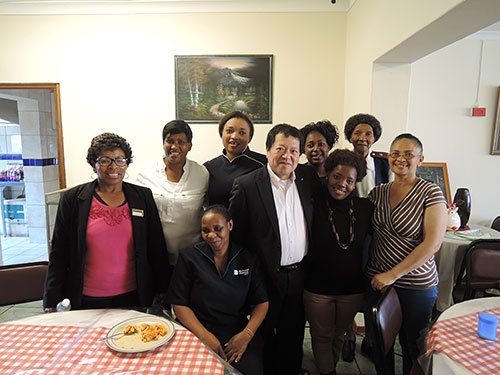
ホスピスで働く看護師たちも「雰囲気が変わった」と口を揃える。真ん中は今回のプロジェクト
を主導した関西ペイントの赤木雄執行役員
社員の目の輝きが変わった
関西ペイントの石野博社長は、これらの事業が収益として貢献するまでには、10年はかかると見る。ただ、それでも、プロジェクトを途中で簡単に止めるつもりはない。「関西ペイントの次の100年を支えるために欠かせない事業になる」(石野社長)との自負があるからだ。
さらに、しっくい塗料のアフリカ展開は、社員のモチベーションを高める効果ももたらしている。自動車向け塗料が中核の時代、関西ペイントの中心顧 客は自動車メーカーだった。いわゆる、企業向けビジネスであり、関西ペイントの社員は自分たちの仕事が消費者にどう貢献しているのかを実感する機会は少な かった。
ところが、ホスピスでの活動は従来のビジネスとは異なり、自分たちの手がけた塗料が、人の命に直接的に貢献していることを実感できる。「社員の目の輝きが変わった。働きがいを高めたという点で大いにプラスになっている」と赤木執行役員は言う。
いわゆる「ミレニアル世代」とよばれる若年世代や、有能な人材の少なくない割合が、報酬や肩書だけではなく、会社に対して働く意味を求めていると 言われる。「自分の手がけている仕事が、社会の役に立っているのか」。そう考える人が増える中で、関西ペイントのアフリカでの展開は、社員に働きがいをも たらす重要な要素になりつつある。
しっくい塗料は、今も改良が続けられている。今年5月には、壁だけでなく、布などに塗料を塗ることも可能になった。この技術を利用すれば、例えば救援テントなどに塗り、無菌状態に近い簡易手術室などに使えるという。
世界の塗料メジャーと関西ペイントとの差は、大きい。それでも世界トップグループ入りを諦めない同社にとって、アフリカ市場の制覇は必達目標だ。 しっくい塗料を始めとした特殊塗料の重要性は今後さらに高まっていくだろう。その意味で、南アフリカのホスピスでつかんだ成果は、同社のアフリカビジネス 拡大のきっかけとなる可能性は十分にある。
Published on October 19, 2016
Author: Satoshi Ebitani
*In case of doubt or discrepancy in the two versions, the Japanese version of the article shall prevail.
出遅れた世界市場攻略の秘策

南アフリカ共和国のヨハネスブルク東部にある終末医療施設、セントフランシス・ケアセンター。
入院する患者に今、小さな奇跡が起きている。
南アフリカ共和国の最大の都市、ヨハネスブルクから東にクルマで約30分。大通りを1本折れると、それまでの喧騒から切り離された閑静な住宅街に入る。その一角にある古い教会の敷地内に、目的の施設はあった。
「セントフランシス・ケアセンター」。末期がんやエイズウイルス(HIV)感染者など、余命の限られた患者を対象に、終末医療を施すホスピスである。身寄りのない幼児30人を含む約60人の患者が生活している。その少なくない数の患者が、ここで最期を迎えるという。
そんな施設で今、ある小さな “奇跡”が起きている。
今年2月にホスピスに入院した女性、ミシェル・ハメレさん(仮名、18歳)。当時既にHIVに感染、発症こそしてはいないものの、免疫力は低下の一途をたどっていた。入院時の体重は31kg、身長は約130cm。年齢の割に明らかに身長が小さく、咳も止まらなかった。
通常の患者なら、そのまま衰弱し、やがて病気を発症して亡くなっていく。ところが、ハメレさんのケースはこれに当てはまらなかった。ホスピスでの 生活が始まると、彼女の体調は劇的に変わったのだ。「日を追うごとに、健康状態が回復、顔色もよくなり、食欲も出るようになった」と、ホスピスの看護責任 者であるウィニー・ドゥラミニ氏は驚く。入院から8カ月後には体重が52kgにまで増加。止まらなかった咳もほとんど出なくなった。
回復の理由は、一義的には看護師が施した的確な治療の効果だが、当の看護士は「治療以外にも理由がある」(ドゥラミニ氏)と言う。そして、棟内の壁を指差した。

ホスピス内にはウイルスを不活性化する特殊な塗料が塗られている。
ホスピスの代表を務めるシンシア・ディックス氏(右)と看護責任者のウィニー・ドゥラミニ氏(左)
実は、院内には特殊な塗料が塗られている。「塗料を塗って以降、多くの患者の体調が改善している」。ホスピスの代表を務めるシンシア・ディックス氏は言う。
特殊塗料には、日本のしっくいに使われる消石灰成分が含まれている。塗ると、表面に無数の微細な孔ができる。そこにウイルスが吸着すると、細孔内部の高アルカリ状態が、ウイルスを不活性化させる。細菌、臭いの成分やカビなども同様の仕組みで細孔に閉じ込め、最後は殺してしまう。つまり、特殊塗料を塗った部屋は、通常よりもバクテリアやウイルスを劇的に少なくできる。
免疫力が低下したエイズ患者は、通常なら害のない種類のウイルスやカビであっても、病気を発症する可能性がある。彼らにとって、無菌に近い環境は、それだけで延命効果につながる。

HIV感染者の生活を劇的に改善し、失われていたかも知れない命を救った特殊塗料。実は開発したのは、塗料大手の関西ペイントだ。日本では、「アレスシックイ」という名称で2008年に発売している。自然素材として古くから用いられてきたしっくいの機能を組み込み、住宅やオフィス向けの高付加価値塗料を展開している。一度塗ると、効果は7~8年ほど持続する。高級ホテルや高級列車の車内などにも使われている。
関西ペイントは当初、消臭やカビ防止効果をしっくい塗料の訴求点としてきたが、その後の研究によって塗料がそれ以上の効能を持つことを発見した。科学的に検証するため、2015年に長崎大学熱帯医学研究所と提携し、ウイルスやバクテリアへの効果について実験を重ねた。
結論は関西ペイントの予想を超えるものだった。HIVのほか、エボラウイルス、鳥インフルエンザウイルスなどにも効果があることが分かったのだ。成果は昨年11月、日本ウイルス学会学術集会でも展示している。
長崎大学との検証結果を受けて、関西ペイントはしっくい塗料の新たな販路開拓の検討を進めている。それが、アフリカを代表とする新興国への展開 だ。「社会問題となっているHIVやエボラウイルスなどの感染症に対して、塗料を使った予防策を政府関係者などに提案している」と関西ペイントの赤木雄執 行役員は言う。
この計画を大きく後押ししたのが、冒頭のホスピスでの成果だった。
南アフリカ日本大使館からの依頼
「しっくい塗料をホスピスに塗っていただけませんか」
2015年、関西ペイントに依頼が舞い込んだ。依頼主は、南アフリカの日本大使館だった。それ以前、関西ペイントの赤木氏は同大使館の廣木重之大 使にしっくい塗料の説明をしたことがあった。「塗料の効能について、大変興味を示されていた」と赤木氏は振り返る。その後、南アフリカ大使館は古くから関 係があったセントフランシス・ケアセンターの改修を、ODA(政府開発援助)を通じて支援することになった。ここで、しっくい塗料を塗るというアイデアが 生まれた。
関西ペイントにとっては、実際の効果を調べるには願ってもない機会だ。申し出にすぐに応じ、実際に塗る際には関西ペイントの社員もホスピスに駆け付けた。

ホスピス内にしっくい塗料を塗っている様子
記者も実際にホスピスを訪れ、院内を歩いた。湿気を吸収しているからだろうか、塗料を塗った部屋は一様に涼しい。特有の陰鬱した雰囲気はあまりなく、むしろ清潔で明るい印象を持った。日差しを浴び、笑みを浮かべながら佇む患者の姿が印象的だった。
世話役の看護士も、塗料の効果を実感する声を多く聞いた。彼女たちは「患者の体調は目に見えて改善している」と口を揃える。院内の雰囲気も随分と明るくなったと言う。
もともと関西ペイントは、自動車向け塗料ビジネスに強く、消費者向けの建築用塗料での存在は小さかった。海外市場拡大を目指し、同社はアフリカを始め世界各国で建築向け塗料ビジネスを強化している。その意味で、しっくい塗料は海外展開の強力な武器となる可能性を秘めている。

しっくい塗料は子供病棟にも塗られた
もちろん、課題もある。一つは、しっくい塗料の効能を、より精緻に検証していく必要がある点だ。看護師の証言は確かに有益だが、現状は主観の域を出ない。科学的根拠が検証されたわけではないため、今後、大学などと共同で効果を検証していく必要がある。
さらに大きなハードルは、アフリカで商品を販売して採算があうかという点だ。特殊塗料を現地で調達するための調達網、生産方法の移転に加え、現地 で広げるためのマーケティング費用などを考えると、コストはそれなりにかかる。一方で、アフリカの平均所得は先進国のそれに比べまだまだ低く、採算を合わせるには相当の工夫が要る。
関西ペイントは、もう1つの特殊塗料である「蚊を寄せ付けない塗料」の展開でNGO(非政府組織)と連携しているが、しっくい塗料でも同様の方法を検討している。これら以外にも、認証機関からのお墨付きをもらうなど、踏むべき手続きは無数にある。

ホスピスで働く看護師たちも「雰囲気が変わった」と口を揃える。真ん中は今回のプロジェクト
を主導した関西ペイントの赤木雄執行役員
社員の目の輝きが変わった
関西ペイントの石野博社長は、これらの事業が収益として貢献するまでには、10年はかかると見る。ただ、それでも、プロジェクトを途中で簡単に止めるつもりはない。「関西ペイントの次の100年を支えるために欠かせない事業になる」(石野社長)との自負があるからだ。
さらに、しっくい塗料のアフリカ展開は、社員のモチベーションを高める効果ももたらしている。自動車向け塗料が中核の時代、関西ペイントの中心顧 客は自動車メーカーだった。いわゆる、企業向けビジネスであり、関西ペイントの社員は自分たちの仕事が消費者にどう貢献しているのかを実感する機会は少な かった。
ところが、ホスピスでの活動は従来のビジネスとは異なり、自分たちの手がけた塗料が、人の命に直接的に貢献していることを実感できる。「社員の目の輝きが変わった。働きがいを高めたという点で大いにプラスになっている」と赤木執行役員は言う。
いわゆる「ミレニアル世代」とよばれる若年世代や、有能な人材の少なくない割合が、報酬や肩書だけではなく、会社に対して働く意味を求めていると 言われる。「自分の手がけている仕事が、社会の役に立っているのか」。そう考える人が増える中で、関西ペイントのアフリカでの展開は、社員に働きがいをも たらす重要な要素になりつつある。
しっくい塗料は、今も改良が続けられている。今年5月には、壁だけでなく、布などに塗料を塗ることも可能になった。この技術を利用すれば、例えば救援テントなどに塗り、無菌状態に近い簡易手術室などに使えるという。
世界の塗料メジャーと関西ペイントとの差は、大きい。それでも世界トップグループ入りを諦めない同社にとって、アフリカ市場の制覇は必達目標だ。 しっくい塗料を始めとした特殊塗料の重要性は今後さらに高まっていくだろう。その意味で、南アフリカのホスピスでつかんだ成果は、同社のアフリカビジネス 拡大のきっかけとなる可能性は十分にある。
Finding Success in Africa – “Life-saving Paint” from Kansai Paint
The location is about a 30-minute drive east of Johannesburg, which is the largest city in the Republic of South Africa. Just one turn off the main street takes you into a quiet residential area that is far removed from the bustle before it. The destination facility was found in the grounds of an old church that forms part of that area.
The “St. Francis Care Centre” is a hospice providing terminal care for patients who have little time left to live, including patients with terminal cancer and patients infected with the AIDS virus (HIV). Sixty patients live here, including thirty young children who have no relatives. This relatively large number of patients spend the end of their lives here.
A small “miracle” is currently occurring at that facility.
Michelle Hamere (pseudonym, 18 years old) is a woman who entered the hospice in February this year. At the time, she was already infected with HIV and, although she was not yet showing symptoms, her immunity was in continuous decline. At the time of her hospitalization, when was about 130 cm tall and weighed 31 kg. She was clearly short for her age and she was continuously coughing.
Normal patients would continue to weaken form that point until they eventually develop the disease and die. However, Ms. Hamere’s case did not fit the normal pattern. After starting her life at the hospice, her physical condition improved dramatically. The hospice matron Winnie Dlamini said that she was surprised as “The state of her health improved each day, her complexion got better and her appetite returned.” Eight months after entering the hospice, her weight had increased to 52 kg and her persistent cough had also almost disappeared.
The reason for the recovery was primarily the effects of the appropriate treatment provided by the nursing staff, but her nurse (Ms. Dlamini) told me that “There is another reason in addition to the treatment.” She then pointed to the walls in the hospice.
Actually, the inside of the hospice has been painted with a special paint. Cynthia Dicks, the representative of the hospice, told me that “The conditions of many patients have improved since the paint was applied.”
The special paint contains a slaked lime ingredients that is used in Shikkui plaster in Japan. When it is applied, innumerable fine pores are formed on its surface. When viruses are adsorbed in them, the highly alkaline state inside the pores inactivates the viruses. Bacteria, odor components and molds are also trapped inside the pores with the same mechanism and are eventually killed. In other words, the number of bacteria and viruses in rooms that have been painted with the special paint can be dramatically reduced from the number in normal rooms.
AIDS patients have reduced immunity and there is a risk of developing disease from viruses and molds that are normally harmless to people. For these patients, simply being in an environment that is nearly germ free can have a life-lengthening effect.
The special paint has dramatically improved the lives of patients infected with HIV and saved lives that may well have been lost. It was developed by the major paint company Kansai Paint. It was launched in Japan in 2008 under the name “Ales SHIQUY.” It incorporates the functions of slaked lime, which has long been used in Japan as a natural material, and is being developed as a paint with high added value for housing and offices. Once it has been applied, the effect continues for seven to eight years. It is also being used in applications such as luxury hotels and on the inside of the carriages of luxury trains.
Initially, Kansai Paint considered the appealing points of SHIQUY paint to be its deodorizing and mold suppression effects. However, in further research, it was discovered that the paint has even greater efficacy. To verify this scientifically, in 2015, the company worked in cooperation with the Nagasaki University Institute of Tropical Medicine on multiple experiments investigating its effect on viruses and bacteria.
The conclusions drawn greatly exceeded the expectations of Kansai Paint. In addition to HIV, it was found that there was also an effect on the Ebola virus, the avian influenza virus and others. The results were even exhibited at the Annual Meeting of the Japanese Society for Virology in November last year.
In response to the results of the verification with Nagasaki University, Kansai Paint is currently considering the development of a new sales channel for the SHIQUY paint – in the emerging nations such as those in Africa. Yu Akaki, an executive director of Kansai Paint, has said that they are making proposals to government related and other personnel regarding the use of the paint as a preventative measure for infectious diseases that are a social problem, such as HIV and the Ebola virus.
The results obtained at the hospice described at the beginning of this article were a great boost to this plan.
A request from the Embassy of Japan in South Africa
“Could you paint a hospice with your SHIQUY paint?”
This request arrived at Kansai Paint in 2015. It was a request from the Embassy of Japan in South Africa. Mr. Akaki of Kansai Paint had previously explained the Shikkui paint to Ambassador Shigeyuki Hiroki of the Embassy. Mr. Akaki looks back on this and says that “He expressed great interest in the effects of the paint.” Later on, it had been decided that the Embassy of Japan in South Africa would use ODA (Official Development Assistance) to support the renovation of the St. Francis Care Centre, which it had long had a relationship with. This is where the idea of applying the SHIQUY paint arose.
For Kansai Paint, this was the best opportunity that they could have wished for to investigate the actual effects. The company soon responded to the request and Kansai Paint employees even went to the hospice whilst it was being painted.
This reporter also visited the hospice and walked around inside. The rooms where the paint had been applied were all equally cool, possibly because the paint was absorbing humidity. There was little of the characteristic gloomy feeling of a hospice and the impression gained was actually of cleanliness and brightness. The scene of the patients basking in the sunlight and resting with smiles on their faces left a strong impression on me.
Many of the nurses who were assisting the patients also said that they had felt the effects of the paint. They all said that there is a visible improvement in the condition of the patients. They also say that the atmosphere in the hospice has become much brighter.
Originally, Kansai Paint has been strong in the business of coating materials for automobiles, but has had little presences in the business of building coating materials for consumers. They have been reinforcing their paint business for construction in Africa and various other countries around the world in an effort to expand their market overseas. (See the company research dated October 17, 2016 for details of this.) In this sense, the SHIQUY paint has great potential as a powerful tool for expansion overseas.
Of course, there are issues to be solved. First of all, it is necessary to more precisely verify the efficacy of the SHIQUY paint. The testimony of the nurses is certainly useful, but it is currently no more than subjective evidence. The scientific basis for it has not yet been verified, so it will be necessary from now onwards to verify the effects in cooperation with parties such as universities.
An even greater hurdle is whether or not it can be profitable to sell the product in Africa. In addition to the supply network necessary to procure the special paint locally and the transferring of the production methods, if we also consider other factors such as the marketing expenses required to promote the products locally, then it seems that the costs will be quite expensive. However, the average incomes in Africa are still low compared with those in the advanced countries, so making a profit will require a large effort.
Kansai Paint is currently cooperating with an NGO (Non-Governmental Organization) on the extension of another special paint that repels mosquitoes and the company is considering using the same methods for the SHIQUY paint. In addition to this, there are innumerable other procedures to be followed, including to obtain endorsement from certification authorities.
The shine in the employees’ eyes has changed
President Horoshi Ishino of Kansai Paint is estimating that it will take ten years before these projects can contribute to profits. However, despite this, he has no intention of simply stopping the projects before they are completed. This is because he is confident that “This will become essential business to support the next 100 years of Kansai Paint.” (President Ishino)
Furthermore, the extension of SHIQUY paint to Africa is also having the effect of raising the motivation of the employees. In the era when the company’s core business was in coating materials for automobiles, the main customers of Kansai Paint were automobile manufacturers. In other words, it as business for businesses and there was little opportunity for the Kansai Paint employees to experience how their work was contributing to the lives of consumers.
However, the activities in the hospice differ from the conventional business in that it is possible for the employees to feel how the paint that they have developed themselves is directly contributing to human life. Executive officer Akaki says that “The shine in the employees’ eyes has changed. This has been highly beneficial in that it has raised the job satisfaction.”
It is said that the young generation known as the “Millennials” and also a relatively high proportion of capable personnel are looking for not only salary and job titles, but are also demanding some meaning in the work from the company. As more and more people are asking themselves whether the work they are doing is useful for society, the expansion of Kansai Paint in Africa is becoming an important element providing job satisfaction for the employees.
mprovements to the SHIQUY paint are still in progress. In May this year, it became possible to apply the paint to cloth and others in addition to painting it on walls. If this technology is used, it may be possible to apply it to things such as rescue tents, so that they can be used as simple operating theaters that are close to a germ-free state.
The gap between the major paint companies of the world and Kansai Paint is still large. However, Kansai Paint is not giving up on the possibility of joining the top group globally and conquering the market in Africa is a goal that must be achieved for this. The importance of the special paints such as the SHIQUY paint will no doubt continue to grow. In this sense, the results obtained in the hospice in South Africa could quite possibly prove to be the trigger for the expansion of the company’s business in Africa.
The location is about a 30-minute drive east of Johannesburg, which is the largest city in the Republic of South Africa. Just one turn off the main street takes you into a quiet residential area that is far removed from the bustle before it. The destination facility was found in the grounds of an old church that forms part of that area.
The “St. Francis Care Centre” is a hospice providing terminal care for patients who have little time left to live, including patients with terminal cancer and patients infected with the AIDS virus (HIV). Sixty patients live here, including thirty young children who have no relatives. This relatively large number of patients spend the end of their lives here.
A small “miracle” is currently occurring at that facility.
Michelle Hamere (pseudonym, 18 years old) is a woman who entered the hospice in February this year. At the time, she was already infected with HIV and, although she was not yet showing symptoms, her immunity was in continuous decline. At the time of her hospitalization, when was about 130 cm tall and weighed 31 kg. She was clearly short for her age and she was continuously coughing.
Normal patients would continue to weaken form that point until they eventually develop the disease and die. However, Ms. Hamere’s case did not fit the normal pattern. After starting her life at the hospice, her physical condition improved dramatically. The hospice matron Winnie Dlamini said that she was surprised as “The state of her health improved each day, her complexion got better and her appetite returned.” Eight months after entering the hospice, her weight had increased to 52 kg and her persistent cough had also almost disappeared.
The reason for the recovery was primarily the effects of the appropriate treatment provided by the nursing staff, but her nurse (Ms. Dlamini) told me that “There is another reason in addition to the treatment.” She then pointed to the walls in the hospice.
Actually, the inside of the hospice has been painted with a special paint. Cynthia Dicks, the representative of the hospice, told me that “The conditions of many patients have improved since the paint was applied.”
The special paint contains a slaked lime ingredients that is used in Shikkui plaster in Japan. When it is applied, innumerable fine pores are formed on its surface. When viruses are adsorbed in them, the highly alkaline state inside the pores inactivates the viruses. Bacteria, odor components and molds are also trapped inside the pores with the same mechanism and are eventually killed. In other words, the number of bacteria and viruses in rooms that have been painted with the special paint can be dramatically reduced from the number in normal rooms.
AIDS patients have reduced immunity and there is a risk of developing disease from viruses and molds that are normally harmless to people. For these patients, simply being in an environment that is nearly germ free can have a life-lengthening effect.
The special paint has dramatically improved the lives of patients infected with HIV and saved lives that may well have been lost. It was developed by the major paint company Kansai Paint. It was launched in Japan in 2008 under the name “Ales SHIQUY.” It incorporates the functions of slaked lime, which has long been used in Japan as a natural material, and is being developed as a paint with high added value for housing and offices. Once it has been applied, the effect continues for seven to eight years. It is also being used in applications such as luxury hotels and on the inside of the carriages of luxury trains.
Initially, Kansai Paint considered the appealing points of SHIQUY paint to be its deodorizing and mold suppression effects. However, in further research, it was discovered that the paint has even greater efficacy. To verify this scientifically, in 2015, the company worked in cooperation with the Nagasaki University Institute of Tropical Medicine on multiple experiments investigating its effect on viruses and bacteria.
The conclusions drawn greatly exceeded the expectations of Kansai Paint. In addition to HIV, it was found that there was also an effect on the Ebola virus, the avian influenza virus and others. The results were even exhibited at the Annual Meeting of the Japanese Society for Virology in November last year.
In response to the results of the verification with Nagasaki University, Kansai Paint is currently considering the development of a new sales channel for the SHIQUY paint – in the emerging nations such as those in Africa. Yu Akaki, an executive director of Kansai Paint, has said that they are making proposals to government related and other personnel regarding the use of the paint as a preventative measure for infectious diseases that are a social problem, such as HIV and the Ebola virus.
The results obtained at the hospice described at the beginning of this article were a great boost to this plan.
A request from the Embassy of Japan in South Africa
“Could you paint a hospice with your SHIQUY paint?”
This request arrived at Kansai Paint in 2015. It was a request from the Embassy of Japan in South Africa. Mr. Akaki of Kansai Paint had previously explained the Shikkui paint to Ambassador Shigeyuki Hiroki of the Embassy. Mr. Akaki looks back on this and says that “He expressed great interest in the effects of the paint.” Later on, it had been decided that the Embassy of Japan in South Africa would use ODA (Official Development Assistance) to support the renovation of the St. Francis Care Centre, which it had long had a relationship with. This is where the idea of applying the SHIQUY paint arose.
For Kansai Paint, this was the best opportunity that they could have wished for to investigate the actual effects. The company soon responded to the request and Kansai Paint employees even went to the hospice whilst it was being painted.
This reporter also visited the hospice and walked around inside. The rooms where the paint had been applied were all equally cool, possibly because the paint was absorbing humidity. There was little of the characteristic gloomy feeling of a hospice and the impression gained was actually of cleanliness and brightness. The scene of the patients basking in the sunlight and resting with smiles on their faces left a strong impression on me.
Many of the nurses who were assisting the patients also said that they had felt the effects of the paint. They all said that there is a visible improvement in the condition of the patients. They also say that the atmosphere in the hospice has become much brighter.
Originally, Kansai Paint has been strong in the business of coating materials for automobiles, but has had little presences in the business of building coating materials for consumers. They have been reinforcing their paint business for construction in Africa and various other countries around the world in an effort to expand their market overseas. (See the company research dated October 17, 2016 for details of this.) In this sense, the SHIQUY paint has great potential as a powerful tool for expansion overseas.
Of course, there are issues to be solved. First of all, it is necessary to more precisely verify the efficacy of the SHIQUY paint. The testimony of the nurses is certainly useful, but it is currently no more than subjective evidence. The scientific basis for it has not yet been verified, so it will be necessary from now onwards to verify the effects in cooperation with parties such as universities.
An even greater hurdle is whether or not it can be profitable to sell the product in Africa. In addition to the supply network necessary to procure the special paint locally and the transferring of the production methods, if we also consider other factors such as the marketing expenses required to promote the products locally, then it seems that the costs will be quite expensive. However, the average incomes in Africa are still low compared with those in the advanced countries, so making a profit will require a large effort.
Kansai Paint is currently cooperating with an NGO (Non-Governmental Organization) on the extension of another special paint that repels mosquitoes and the company is considering using the same methods for the SHIQUY paint. In addition to this, there are innumerable other procedures to be followed, including to obtain endorsement from certification authorities.
The shine in the employees’ eyes has changed
President Horoshi Ishino of Kansai Paint is estimating that it will take ten years before these projects can contribute to profits. However, despite this, he has no intention of simply stopping the projects before they are completed. This is because he is confident that “This will become essential business to support the next 100 years of Kansai Paint.” (President Ishino)
Furthermore, the extension of SHIQUY paint to Africa is also having the effect of raising the motivation of the employees. In the era when the company’s core business was in coating materials for automobiles, the main customers of Kansai Paint were automobile manufacturers. In other words, it as business for businesses and there was little opportunity for the Kansai Paint employees to experience how their work was contributing to the lives of consumers.
However, the activities in the hospice differ from the conventional business in that it is possible for the employees to feel how the paint that they have developed themselves is directly contributing to human life. Executive officer Akaki says that “The shine in the employees’ eyes has changed. This has been highly beneficial in that it has raised the job satisfaction.”
It is said that the young generation known as the “Millennials” and also a relatively high proportion of capable personnel are looking for not only salary and job titles, but are also demanding some meaning in the work from the company. As more and more people are asking themselves whether the work they are doing is useful for society, the expansion of Kansai Paint in Africa is becoming an important element providing job satisfaction for the employees.
mprovements to the SHIQUY paint are still in progress. In May this year, it became possible to apply the paint to cloth and others in addition to painting it on walls. If this technology is used, it may be possible to apply it to things such as rescue tents, so that they can be used as simple operating theaters that are close to a germ-free state.
The gap between the major paint companies of the world and Kansai Paint is still large. However, Kansai Paint is not giving up on the possibility of joining the top group globally and conquering the market in Africa is a goal that must be achieved for this. The importance of the special paints such as the SHIQUY paint will no doubt continue to grow. In this sense, the results obtained in the hospice in South Africa could quite possibly prove to be the trigger for the expansion of the company’s business in Africa.




